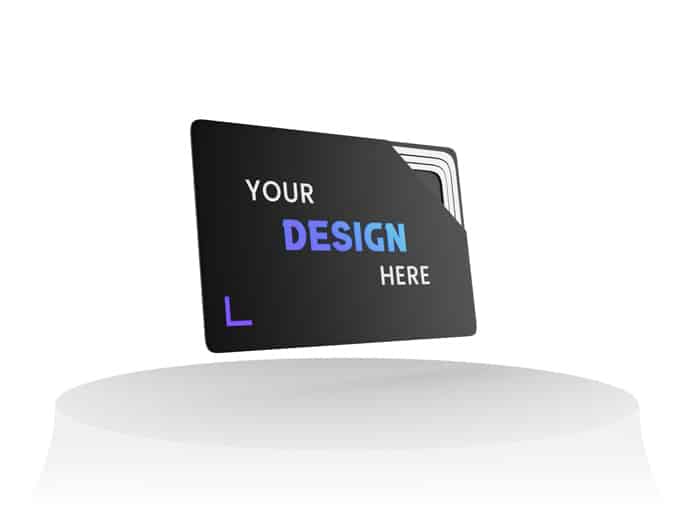
5 ways to use business cards to generate leads

Not only are they a quick and easy way of sharing your contact details, they’re also a way of maintaining an almost direct link with the person receiving them.
There are many ways to use business cards as a marketing and promotional tool.
In this article, we’ll look at five of the most effective.
Use networking events to distribute your business cards
We don’t think about it enough, especially at a time when all means of communication seem to be dematerialized, but meetings between people are still an opportunity to make contacts that can be highly profitable from a marketing point of view. It’s a networking technique.
This is why it’s a good idea to assert your presence at trade shows, but also at cocktail parties or inauguration evenings.
Association meetings, especially when the subject is related to an issue that affects your professional world, can be an opportunity to meet people with whom a business relationship can later be established.
But once the meeting is over, you still need to be remembered: this is where the business card is irreplaceable, whether it’s printed on thick paper or cardboard, as has been done for decades, or made from less common materials such as metal or wood.
That’s why you should never go to a place where many people are going to meet without having a stock of business cards with you.
As a matter of courtesy, never forget to ask for the other person’s business card in return: this is usually done almost automatically, but if you forget, it’s always a good idea to apply a principle of reciprocity.
And if you want to stand out from the competition, it may be a good idea to use something other than traditional cardboard as a support for your business card: in this respect, bamboo, metal or even leather can be much more effective than cardboard.
Generally speaking, anything of quality tends to be kept much longer than the usual.
Leave business cards in places where potential prospects are likely to be.
At least once in our lives, we’ve all seen those business cards pinned up at the grocer’s or the baker’s, left by cleaning ladies, caregivers offering personal services, multiservice professionals or students ready to give French or math lessons to pupils.
Indeed, with so many customers passing through this type of store, there’s a strong likelihood that people will be interested in the offers highlighted.
For you, as a professional, it’s the same thing: it’s necessary and useful to leave your business cards in places where potential prospects may pass by.
So it’s a good idea to ask around to find these places, which aren’t necessarily the ones you’d first think of.
For example, it’s probably not a good idea to leave business cards in a company lobby, as most employees come and go without paying much attention to what’s there.
On the other hand, it may be quite relevant to know where company executives meet for a drink after their day’s work, or which restaurants your targets frequent.
Even gyms can be ideal places to drop off business cards!
Include your business card in every package or folder you send to your customers
If you run an online store or send parcels to your customers, never forget to include an attractive business card inside: after all, you should always make it easy for your customers to find the information they need.
Don’t assume that the invoice customers will find in the package will be enough to inform them if they ever need to find your contact details.
With the abundance of information and incessant advertising, many people no longer have the patience to spend long minutes searching for the information they’re interested in: almost everything needs to be accessible immediately!
Enclosing a business card in a parcel is just one more way to make your company or brand stand out and be remembered.
Similarly, when handing out information packs or advertising brochures, staple your business card to the documents so that it doesn’t get lost.
It’s also a good idea to have a simple QR code printed on the back of the documents you hand out to your prospects, which they can scan to easily find your contact details.
Choose a digital business card for even greater efficiency
We’ve talked about infobesity, a neologism coined from the words “obesity” and “information” to describe the staggering amount of information and advertising we receive every day on our smartphones, tablets or computers.
And yet, as all marketing studies show, it’s the ease of access to information that makes these connected objects so effective and attractive.
So we can use their appeal to share, for example, business contact details and important documents: that’s where the digital business card comes in, this communicating object that looks like a traditional business card but usually features an NFC chip and a QR code.
As well as being able to easily scan the QR code using the camera included in almost all current cell phones, which will automatically open a browser, the NFC chip will transmit your contact details directly, reliably and very accurately, without even needing to connect the two smartphones.
As a result, the person with whom you’ve exchanged will always have your contact details and any information you’ve deemed useful to share.
In this way, you avoid what happens in more than 8 out of 10 cases, where the business card is quickly discarded without even having been used.
What’s more, the NFC chip can transmit much more than just contact details: PDF files, infographics, ebooks and even videos can be easily shared.
A final advantage of the digital business card is that the information stored on it can be updated quickly and easily: there’s no need to reprint large quantities of business cards, as is all too often the case with cards printed on paper.
By logging on to a simple server, you can access your personal space and modify the information and files you wish to distribute to your prospects.
Gamify your business card!
It’s a trick that’s still not widely used, because the way companies work is still very corporate.
However, marketing specialists tell us that gamification – adapting principles from games to the world of marketing – can have a major influence on the interest a client may show in your services or offer.
For example, you could insert a code on the back of your business card to access bonuses or discounts in a commercial context.
You can also tell your contact that he or she will be able to take a virtual tour of your premises, if, for example, they are of particular architectural interest, and that certain rooms will only be accessible by scanning a QR Code printed on the card.
In the same way, your customer can become part of a community that will benefit from exclusive information if he logs in using a code present on a business card manufactured in a limited edition of 50.
And why not include a link to an online game on your business card: in this case, the gamification principle is used directly to play!
These playful suggestions will increase the chances that your contact won’t throw your card away, as it will potentially bring them one or more advantages.
Written by Camille BODET
The digital business card is a real ally for professionals wishing to promote their business effectively and instantly. In the...Lire la suite
VKARD is an innovative and effective solution to help all professionals stand out from the crowd and reinforce their brand...Lire la suite
If you prepare properly for a job interview, you'll have every chance of winning over the recruiter and getting the...Lire la suite
LinkedIn is a world-renowned business platform, and for good reason! Thanks to its many networking options, LinkedIn is the tool...Lire la suite
Find out how Leexi AI optimizes the management of videoconferences and business calls, saving time and improving efficiency.
In the professional sphere, it's vital to know how to convey certain strong values in order to stand out and...Lire la suite
Mastering the art of conversation is a real asset! By mastering the subtle art of conversation, you'll be able to...Lire la suite
Are you taking part in a trade event and want to do everything you can to make a good impression?...Lire la suite
CRM (Customer Relationship Management) represents a genuine corporate strategy for managing business contacts. This popular tool for professionals is in...Lire la suite
At a time when the professional world is in a perpetual state of competition, we might wonder what place altruism,...Lire la suite















